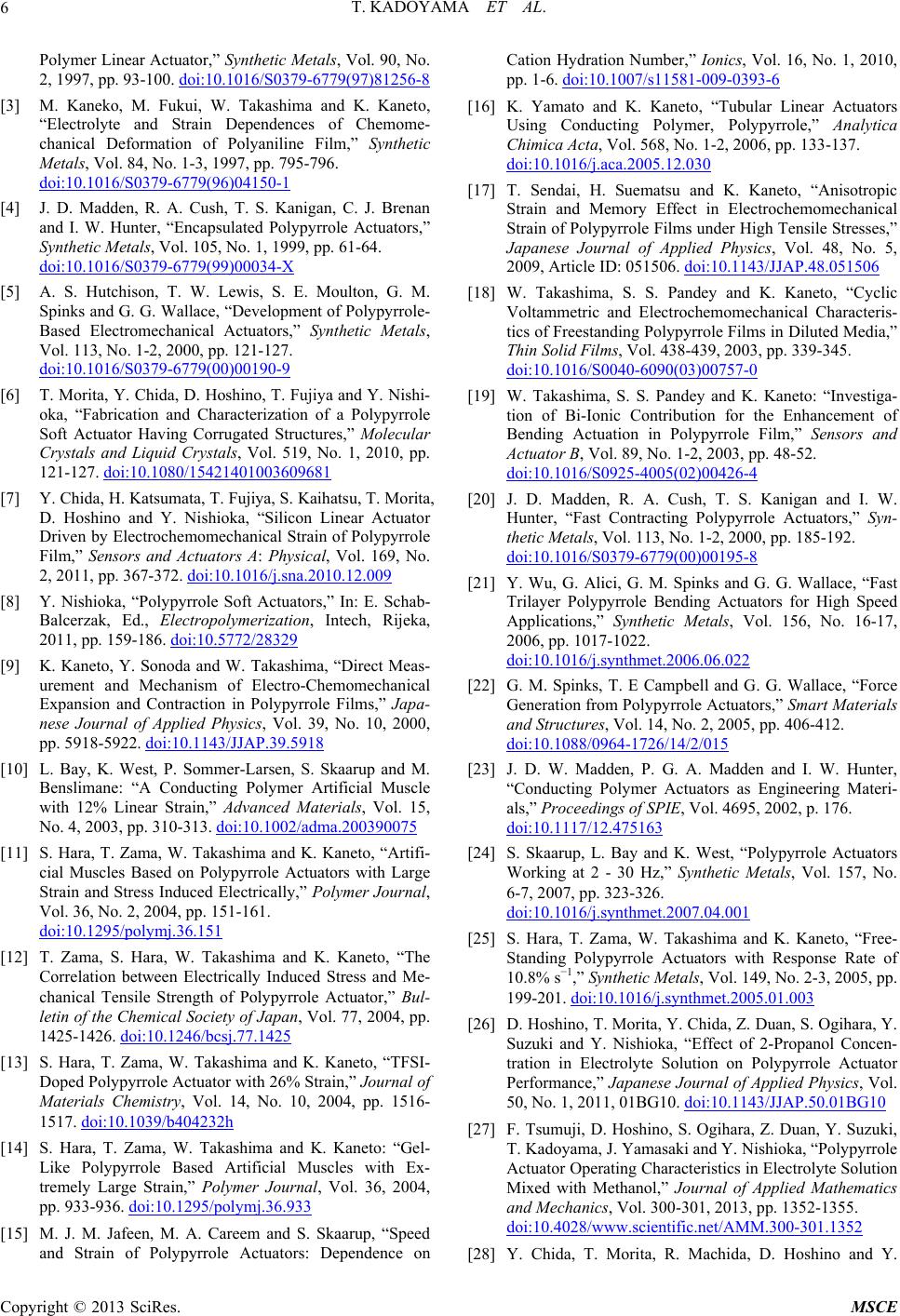
T. KADOYAMA ET AL.
6
Polymer Linear Actuator,” Synthetic Metals, Vol. 90, No.
2, 1997, pp. 93-100. doi:10.1016/S0379-6779(97)81256-8
[3] M. Kaneko, M. Fukui, W. Takashima and K. Kaneto,
“Electrolyte and Strain Dependences of Chemome-
chanical Deformation of Polyaniline Film,” Synthetic
Metals, Vol. 84, No. 1-3, 1997, pp. 795-796.
doi:10.1016/S0379-6779(96)04150-1
[4] J. D. Madden, R. A. Cush, T. S. Kanigan, C. J. Brenan
and I. W. Hunter, “Encapsulated Polypyrrole Actuators,”
Synthetic Metals, Vol. 105, No. 1, 1999, pp. 61-64.
doi:10.1016/S0379-6779(99)00034-X
[5] A. S. Hutchison, T. W. Lewis, S. E. Moulton, G. M.
Spinks and G. G. Wallace, “Development of Polypyrrole-
Based Electromechanical Actuators,” Synthetic Metals,
Vol. 113, No. 1-2, 2000, pp. 121-127.
doi:10.1016/S0379-6779(00)00190-9
[6] T. Morita, Y. Chida, D. Hoshino, T. Fujiya and Y. Nishi-
oka, “Fabrication and Characterization of a Polypyrrole
Soft Actuator Having Corrugated Structures,” Molecular
Crystals and Liquid Crystals, Vol. 519, No. 1, 2010, pp.
121-127. doi:10.1080/15421401003609681
[7] Y. Chida, H. Katsumata, T. Fujiya, S. Kaihatsu, T. Morita,
D. Hoshino and Y. Nishioka, “Silicon Linear Actuator
Driven by Electrochemomechanical Strain of Polypyrrole
Film,” Sensors and Actuators A: Physical, Vol. 169, No.
2, 2011, pp. 367-372. doi:10.1016/j.sna.2010.12.009
[8] Y. Nishioka, “Polypyrrole Soft Actuators,” In: E. Schab-
Balcerzak, Ed., Electropolymerization, Intech, Rijeka,
2011, pp. 159-186. doi:10.5772/28329
[9] K. Kaneto, Y. Sonoda and W. Takashima, “Direct Meas-
urement and Mechanism of Electro-Chemomechanical
Expansion and Contraction in Polypyrrole Films,” Japa-
nese Journal of Applied Physics, Vol. 39, No. 10, 2000,
pp. 5918-5922. doi:10.1143/JJAP.39.5918
[10] L. Bay, K. West, P. Sommer-Larsen, S. Skaarup and M.
Benslimane: “A Conducting Polymer Artificial Muscle
with 12% Linear Strain,” Advanced Materials, Vol. 15,
No. 4, 2003, pp. 310-313. doi:10.1002/adma.200390075
[11] S. Hara, T. Zama, W. Takashima and K. Kaneto, “Artifi-
cial Muscles Based on Polypyrrole Actuators with Large
Strain and Stress Induced Electrically,” Polymer Journal,
Vol. 36, No. 2, 2004, pp. 151-161.
doi:10.1295/polymj.36.151
[12] T. Zama, S. Hara, W. Takashima and K. Kaneto, “The
Correlation between Electrically Induced Stress and Me-
chanical Tensile Strength of Polypyrrole Actuator,” Bul-
letin of the Chemical Society of Japan, Vol. 77, 2004, pp.
1425-1426. doi:10.1246/bcsj.77.1425
[13] S. Hara, T. Zama, W. Takashima and K. Kaneto, “TFSI-
Doped Polypyrrole Actuator with 26% Strain,” Journal of
Materials Chemistry, Vol. 14, No. 10, 2004, pp. 1516-
1517. doi:10.1039/b404232h
[14] S. Hara, T. Zama, W. Takashima and K. Kaneto: “Gel-
Like Polypyrrole Based Artificial Muscles with Ex-
tremely Large Strain,” Polymer Journal, Vol. 36, 2004,
pp. 933-936. doi:10.1295/polymj.36.933
[15] M. J. M. Jafeen, M. A. Careem and S. Skaarup, “Speed
and Strain of Polypyrrole Actuators: Dependence on
Cation Hydration Number,” Ionics, Vol. 16, No. 1, 2010,
pp. 1-6. doi:10.1007/s11581-009-0393-6
[16] K. Yamato and K. Kaneto, “Tubular Linear Actuators
Using Conducting Polymer, Polypyrrole,” Analytica
Chimica Acta, Vol. 568, No. 1-2, 2006, pp. 133-137.
doi:10.1016/j.aca.2005.12.030
[17] T. Sendai, H. Suematsu and K. Kaneto, “Anisotropic
Strain and Memory Effect in Electrochemomechanical
Strain of Polypyrrole Films under High Tensile Stresses,”
Japanese Journal of Applied Physics, Vol. 48, No. 5,
2009, Article ID: 051506. doi:10.1143/JJAP.48.051506
[18] W. Takashima, S. S. Pandey and K. Kaneto, “Cyclic
Voltammetric and Electrochemomechanical Characteris-
tics of Freestanding Polypyrrole Films in Diluted Media,”
Thin Solid Films, Vol. 438-439, 2003, pp. 339-345.
doi:10.1016/S0040-6090(03)00757-0
[19] W. Takashima, S. S. Pandey and K. Kaneto: “Investiga-
tion of Bi-Ionic Contribution for the Enhancement of
Bending Actuation in Polypyrrole Film,” Sensors and
Actuator B, Vol. 89, No. 1-2, 2003, pp. 48-52.
doi:10.1016/S0925-4005(02)00426-4
[20] J. D. Madden, R. A. Cush, T. S. Kanigan and I. W.
Hunter, “Fast Contracting Polypyrrole Actuators,” Syn-
thetic Metals, Vol. 113, No. 1-2, 2000, pp. 185-192.
doi:10.1016/S0379-6779(00)00195-8
[21] Y. Wu, G. Alici, G. M. Spinks and G. G. Wallace, “Fast
Trilayer Polypyrrole Bending Actuators for High Speed
Applications,” Synthetic Metals, Vol. 156, No. 16-17,
2006, pp. 1017-1022.
doi:10.1016/j.synthmet.2006.06.022
[22] G. M. Spinks, T. E Campbell and G. G. Wallace, “Force
Generation from Polypyrrole Actuators,” Smart Materials
and Structures, Vol. 14, No. 2, 2005, pp. 406-412.
doi:10.1088/0964-1726/14/2/015
[23] J. D. W. Madden, P. G. A. Madden and I. W. Hunter,
“Conducting Polymer Actuators as Engineering Materi-
als,” Proceedings of SPIE, Vol. 4695, 2002, p. 176.
doi:10.1117/12.475163
[24] S. Skaarup, L. Bay and K. West, “Polypyrrole Actuators
Working at 2 - 30 Hz,” Synthetic Metals, Vol. 157, No.
6-7, 2007, pp. 323-326.
doi:10.1016/j.synthmet.2007.04.001
[25] S. Hara, T. Zama, W. Takashima and K. Kaneto, “Free-
Standing Polypyrrole Actuators with Response Rate of
10.8% s−1,” Synthetic Metals, Vol. 149, No. 2-3, 2005, pp.
199-201. doi:10.1016/j.synthmet.2005.01.003
[26] D. Hoshino, T. Morita, Y. Chida, Z. Duan, S. Ogihara, Y.
Suzuki and Y. Nishioka, “Effect of 2-Propanol Concen-
tration in Electrolyte Solution on Polypyrrole Actuator
Performance,” Japanese Journal of Applied Physics, Vol.
50, No. 1, 2011, 01BG10. doi:10.1143/JJAP.50.01BG10
[27] F. Tsumuji, D. Hoshino, S. Ogihara, Z. Duan, Y. Suzuki,
T. Kadoyama, J. Yamasaki and Y. Nishioka, “Polypyrrole
Actuator Operating Characteristics in Electrolyte Solution
Mixed with Methanol,” Journal of Applied Mathematics
and Mechanics, Vol. 300-301, 2013, pp. 1352-1355.
doi:10.4028/www.scientific.net/AMM.300-301.1352
[28] Y. Chida, T. Morita, R. Machida, D. Hoshino and Y.
Copyright © 2013 SciRes. MSCE